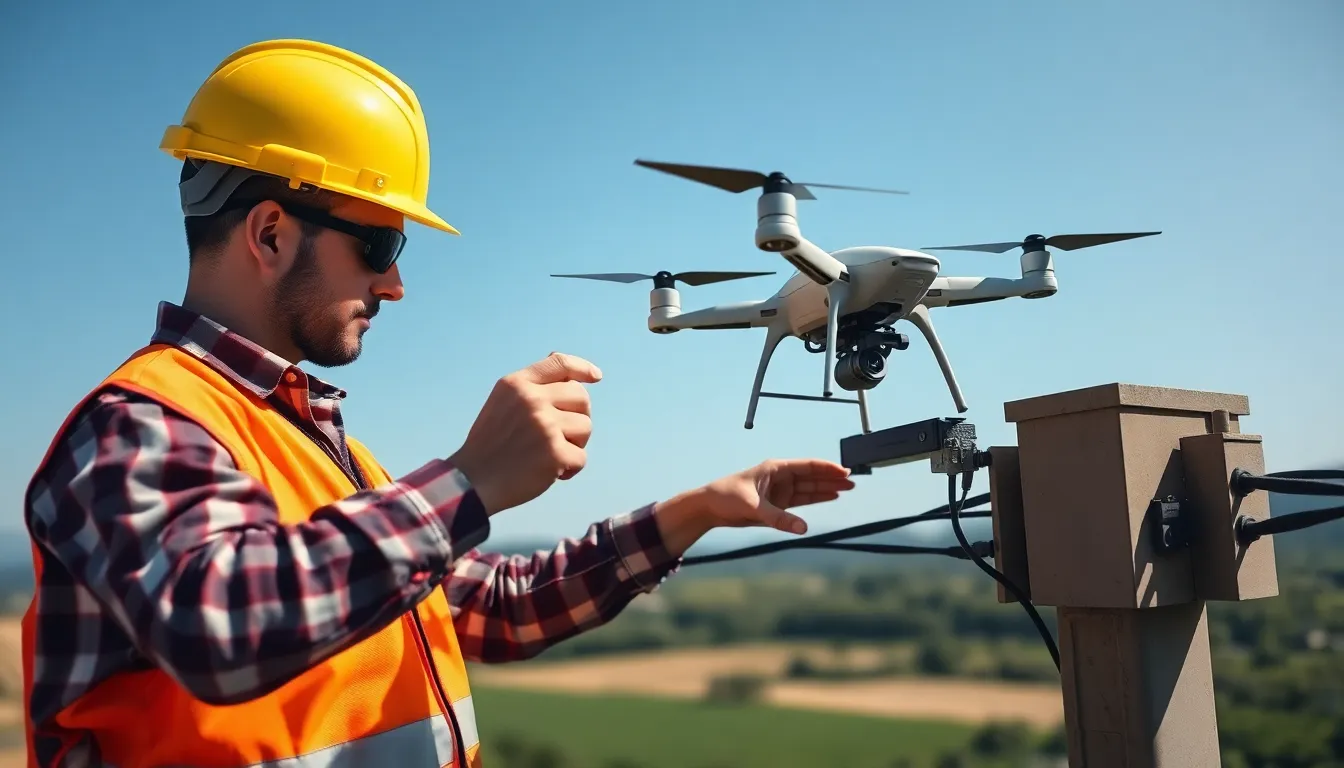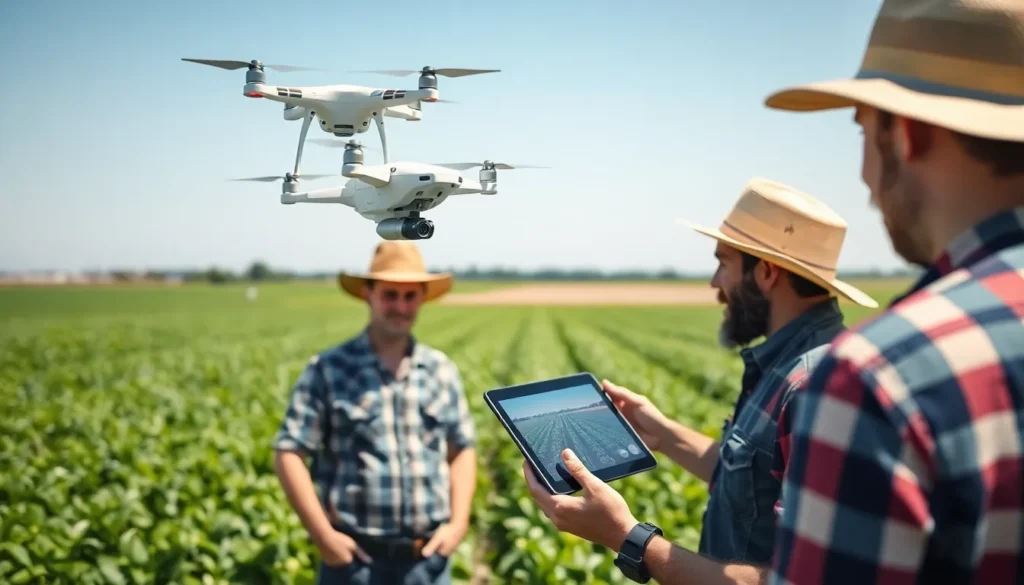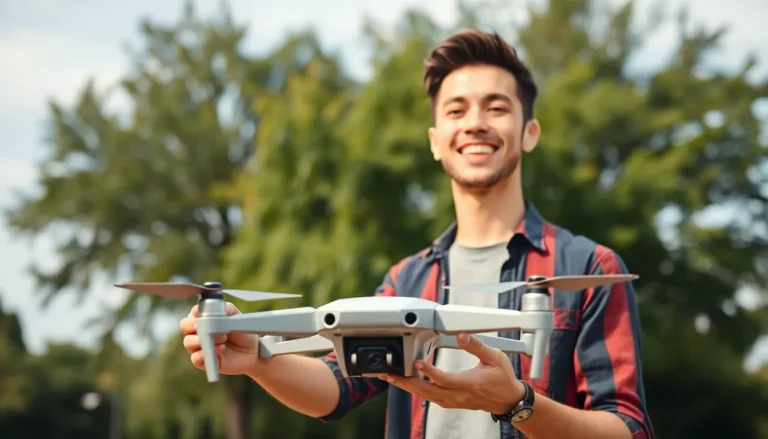Table of Contents
ToggleImagine soaring through the skies with a drone that not only captures stunning aerial views but also overlays vital information right before your eyes. Welcome to the world of drone augmented reality, where technology meets imagination in the most exhilarating way. This fusion of drones and AR is transforming industries from real estate to agriculture, making tasks easier, faster, and a whole lot cooler.
Overview of Drone Augmented Reality
Drone augmented reality integrates real-time data with aerial imagery, enhancing the user’s experience. Innovations in this field improve data visualization, facilitating better decision-making across various applications.
Users in the real estate sector leverage this technology to showcase properties dynamically. By overlaying digital information on live video feeds, potential buyers gain insights into property features instantly.
In agriculture, farmers utilize drones equipped with augmented reality to monitor crop health. This combination allows for the identification of issues like nutrient deficiencies and pest infestations quickly.
Maintenance tasks benefit from drone augmented reality as well. Technicians assess infrastructure such as power lines and bridges with live visual overlays. This approach significantly increases inspection accuracy and reduces downtime.
Education and training programs incorporate drone augmented reality for hands-on learning. Students understand complex subjects effectively when they engage with 3D models overlaid onto real-world scenarios.
Additionally, emergency responders use this technology for situational awareness during crises. By accessing critical information in real time, teams can coordinate more effectively during disasters.
Businesses exploring drone augmented reality gain a competitive edge. Organizations can enhance productivity and reduce costs by streamlining workflows. As applications expand, more industries will experience the benefits of this technology, positioning it as a vital tool in modern operations.
Applications of Drone Augmented Reality

Drone augmented reality finds diverse applications across many sectors. Enhanced efficiency and improved decision-making characterize these uses.
Industrial Uses
Industries leverage drone augmented reality for maintenance and inspections. Technicians conduct visual assessments of power lines, wind turbines, and pipelines, with real-time overlays providing vital data. Enhanced visualization allows for swift identification of issues. Construction firms benefit from 3D models presented over existing structures, leading to streamlined project management. Surveillance and monitoring tasks see improved execution thanks to enriched data layers. Companies embracing this technology reduce downtime significantly, making operations more cost-effective.
Recreational Uses
A variety of recreational activities also utilize drone augmented reality. Enthusiasts engage in competitive racing, as augmented overlays offer insights into performance metrics and track details. Photographers capture breathtaking landscapes layered with digital enhancements, enriching images further. Gamers create immersive experiences where virtual challenges overlap with real-world environments, enhancing gameplay engagement. Families enjoy outdoor adventures with informative overlays that point out landmarks and geological features. Users experience new dimensions of interaction, combining reality with virtual elements for enhanced enjoyment.
Benefits of Drone Augmented Reality
Drone augmented reality offers several significant benefits that enhance various operations in multiple sectors. These advantages include enhanced visualization and improved safety.
Enhanced Visualization
Enhanced visualization stands out as one of the foremost benefits of drone augmented reality. Users gain the ability to overlay critical data onto live video feeds, which leads to a more intuitive understanding of complex environments. Potential buyers in real estate can explore properties with dynamic information, making informed decisions quickly. In agriculture, farmers identify crop health issues more accurately by viewing comprehensive visuals of their fields. Technicians inspecting infrastructure, such as bridges and power lines, benefit from real-time overlays that clearly depict issues. Engaging with 3D models during educational experiences allows students to visualize concepts in a tangible way. This technology transforms data interpretation into a more accessible format for all users.
Improved Safety
Improved safety represents another crucial benefit provided by drone augmented reality. Emergency responders access real-time data, enabling them to coordinate efforts effectively during crises. Live visual overlays assist in identifying hazards quickly, which enhances situational awareness. Technicians using augmented reality for infrastructure inspection can spot potential problems without placing themselves in danger. Reducing the time spent on site minimizes risks associated with inspections as well. With drones, professionals conduct assessments from a safe distance, mitigating the risk of accidents. As a result, this innovative technology fosters safer working environments across industries, allowing personnel to focus more on executing their tasks efficiently.
Challenges and Limitations
Drone augmented reality faces notable challenges that can hinder its full potential. Various technical issues and regulatory concerns impact its implementation across industries.
Technical Issues
Hardware constraints can limit the effectiveness of drone augmented reality systems. Drones often struggle with data processing capabilities, causing lag in real-time overlays. Additionally, compatibility with augmented reality software might not always be seamless. Battery life presents another challenge; drones typically require frequent recharging, reducing operational time. Signal interference poses a significant threat as well, affecting the reliability of data transmission during flights. Furthermore, weather conditions like fog or rain can impair both visibility and sensor performance, making it difficult to utilize augmented reality effectively.
Regulatory Concerns
Regulatory frameworks surrounding drones often create obstacles for widespread adoption. Many countries impose strict regulations regarding drone operations, including flight altitude restrictions and no-fly zones. Compliance with these regulations can hinder operational flexibility. Furthermore, privacy concerns arise when drones capture images or video within populated areas. Public acceptance also plays a role; community trust in drone operation can affect project viability. Organizations must navigate complex legal landscapes to ensure adherence to safety and privacy laws, which can delay project timelines and increase costs.
Future Trends in Drone Augmented Reality
Emerging trends shape the future of drone augmented reality, impacting various industries. Increased integration of artificial intelligence enhances data analysis capabilities. Users benefit from real-time insights as drones process information more efficiently, enabling quicker responses to dynamic situations.
Collaboration tools are gaining traction, promoting teamwork among multiple users. These tools allow technicians in different locations to share visual overlays instantaneously. Improved connectivity also fosters seamless communication, streamlining operations in real-time scenarios.
Another trend involves the development of augmented reality glasses. These devices enable technicians and first responders to access drone feeds hands-free. Such innovations enhance situational awareness, allowing for more effective decision-making in critical environments.
In agriculture, predictive analytics are becoming prevalent. Drones equipped with advanced sensors identify potential crop issues before they escalate. This proactive approach empowers farmers to implement solutions promptly, maximizing yields and minimizing losses.
Significant advancements in battery technology are on the horizon, increasing flight times. Longer flights enhance the operational reach of drones, allowing for comprehensive area coverage. Users can expect improved performance in diverse applications, ranging from infrastructure assessments to search and rescue missions.
Enhanced public acceptance of drone augmented reality is likely as regulatory frameworks evolve. Standardized guidelines promote safer operations while addressing privacy concerns. Organizations that navigate these changes strategically will establish a competitive advantage in their respective fields.
Investment in training programs is crucial for maximizing the benefits of drone augmented reality. Professionals equipped with the right skills can effectively leverage this technology, optimizing workflows across industries. As the market expands, ongoing education will play a vital role in harnessing the full potential of drone augmented reality.
Drone augmented reality represents a significant leap forward in how industries approach tasks and decision-making. By merging real-time data with aerial imagery, it enhances productivity and safety across various sectors. As organizations adapt to this technology, they can transform workflows and improve operational efficiency.
While challenges exist, the potential benefits far outweigh the obstacles. The integration of artificial intelligence and advancements in hardware will pave the way for even greater applications. As public acceptance grows and regulatory frameworks evolve, drone augmented reality will likely become an integral part of modern operations. Embracing this innovative technology positions businesses to thrive in an increasingly competitive landscape.







